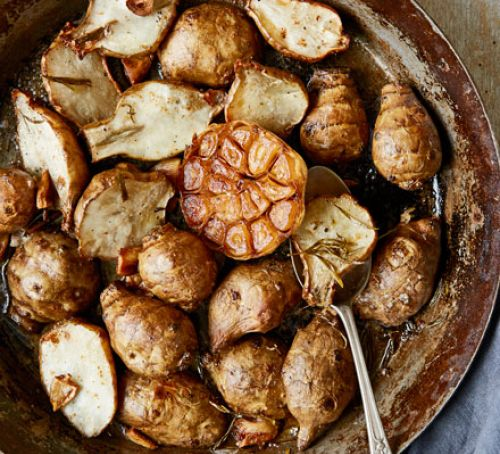Rob’s Recipe of the Week: Crispy artichokes
I don’t think I’ve ever eaten a Jerusalem Artichoke before, but they’re coming in the share next week! After a bit of searching around it seems like roasting is the most common way to eat them and this recipe sounds like a good introduction. Anyone who’s had them before please feel free to suggest other ideas!
Ingredients (scalable)
- 800g Jerusalem artichokes
- 1 garlic bulb, cut down the middle
- 1 tbsp rosemary leaves, chopped
- 3 tbsp rapeseed (or other) oil
- pinch ground mace (Comes from nutmeg shells, so I will probably just substitute nutmeg)
- 20g butter
- 2 tsp lemon juice
Method
Heat oven to 180C/160C fan/gas 4. Soak the artichokes in cold water for 20 mins or so to loosen any dirt, then scrub them with a scourer, being sure to remove any grit. Halve the small ones and quarter the bigger ones, and put them in a roasting tin with the split garlic bulb and rosemary. Coat everything with the oil and season. Roast for 45-50 mins until tender inside and crispy outside.
To finish, squeeze the softened garlic cloves from their skins and toss with the roasted artichokes, along with the mace, butter and lemon juice.
Taken from https://www.bbcgoodfood.com/recipes/crispy-jerusalem-artichokes-roasted-garlic-rosemary
Rebecca’s Recipe of the Week: Parsnip and potato gnocchi with gochujang and hazelnuts
Another brilliant recipe from Meera Sodha: crispy homemade gnocchi tossed with greens and served with spicy Korean chile sauce. Gnocchi can be a little stodgy; the solution is to fry them briefly after they’ve been boiled, so the crunchy outside contrasts with the soft, pillowy inside. A simple red sauce of Korean chile paste, miso and sesame oil provides the perfect foil.
If you don’t know gochujang chile paste, you’re in for a treat. Get some at the KW Oriental Supermarket on Bath Street, or (I suppose) in major supermarkets everywhere.
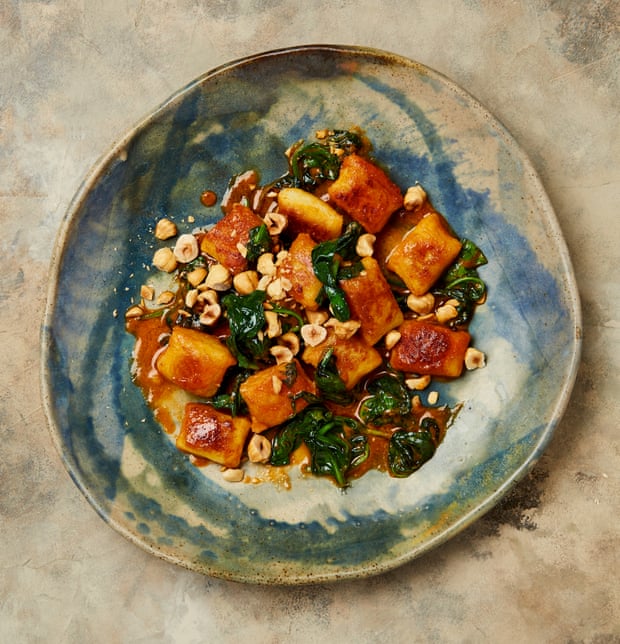
Parsnip and potato gnocchi with gochujang
Serves 2
Ingredients
250g potatoes
150g parsnips
60-100g ‘00’ flour
2 tbsp rapeseed oil, for frying
100g young spinach
25g toasted hazelnuts, chopped
for the chile sauce
4 tsp gochujang paste
4 tbsp white miso
3 tbsp toasted sesame oil
2 tbsp fresh lemon juice
Method
Put the potato and parsnips in a medium saucepan, cover with cold water and bring to a boil. Turn down to a simmer and cook until tender (15-30 minutes, depending on the size).
While the potatoes are cooking make the sauce: combine the sauce ingredients in a small bowl and mix until smooth. Set aside.
When the potatoes are tender, drain and leave to steam dry for 15 minutes. Peel and then mash until very smooth. If you have a potato ricer, this is a good moment to use it.
Add the flour to the mashed/rice potatoes and parsnip, and, using your hands, gently mix it in to form a dough. Add as much flour as you need to stop it sticking to everything, but try not to add more than that. Tip out on to a clean work surface sprinkled with a bit more flour and knead a bit to form a smooth dough.
Divide the dough in two and roll each piece into a sausage around 35cm long x 2cm thick. Cut each sausage into 2cm pieces. If you have the energy, you can use a fork to give each piece some little ridges, which will be cute and make the sauce stick a bit more to the gnocchi. To do this, roll each piece across the tines of a fork, indenting parallel ridges into the individual gnocchi (gnoccho?).
Bring a big pan of water to a rolling boil, drop some of the gnocchi in and and cook for one to two minutes, until they float to the top. Lift them out with the slotted spoon as they rise to the top and and drain in a sieve. Continue until they are all cooked.
In a medium frying pan, heat the rapeseed oil, swirling the pan gently so it coats the base. Once hot, add some of the gnocchi and fry for a couple of minutes, until golden brown underneath. Flip them over and cook for another couple of minutes, to brown the other side. Remove from the pan and then cook any remaining gnocchi.
Add the spinach to the pan and stir gently (so as not to break up the gnocchi) until it wilts. Return any remaining gnocchi to the pan and toss together.
Divide onto two plates and drizzle with a couple of tablespoons of the sauce. Sprinkle with the hazelnuts and serve with extra sauce on the side.
Recipe adapted from Meera Sodha, The Guardian, 23 Nov. 2019.
Rob’s Recipe of the Week: Hip Turnips
Turnips are one of the things I find it hardest to find recipes for. Luckily it seems they are gaining a “hip status” over in New York, so I’ve found a few recipes from Bon Appetit (If you like cooking shows I recommend their youtube channel, especially “It’s Alive” with Brad). I’ve no idea how this one will turn out but I look forward to trying it!
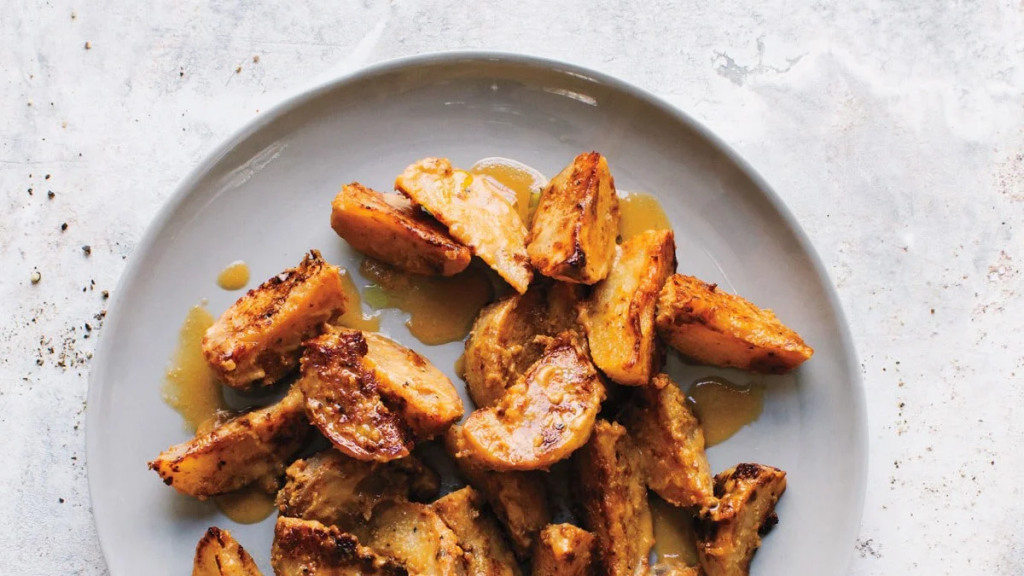
Miso-glazed turnips
Ingredients:
1 pound (450g) turnips trimmed, scrubbed and cut into 2cm wedges
2 tablespoons white miso (near the spices in supermarkets normally)
2 tablespoons unsalted butter
1 teaspoon sugar
2 tablespoons lemon juice
salt and pepper
Method:
Combine turnips, miso, butter, and sugar in a medium skillet/pan, then add water just to cover vegetables. Season with salt and pepper.
Bring to a boil over medium-high heat and cook turnips, turning occasionally, until they are tender and liquid is evaporated, 15–20 minutes.
Once all the liquid has cooked off, keep cooking turnips, tossing occasionally, until they are golden brown and caramelized and the sauce thickens and glazes the vegetables, about 5 minutes longer.
Add lemon juice and a splash of water to pan and swirl to coat turnips. Season with salt and pepper.
Taken from:
https://www.bonappetit.com/recipe/miso-glazed-turnips
as part of a wider set of recipes:
https://www.bonappetit.com/recipes/slideshow/turnip-18-recipes-underrated-root-vegetable
Rebecca’s Recipe of the Week: Golden, Saffron Mash
Saffron tints this dish a beautiful sunny yellow—just the thing to lift the spirits. Anna Jones recommends topping the mash with a poached egg and serving with a side of garlic-infused sautéed greens and toasted almonds. Or you could just eat it in bed, as Nora Ephrom recommended in Heartburn: ‘Nothing like mashed potatoes when you’re feeling blue. Nothing like getting into bed with a bowl of hot mashed potatoes already loaded with butter, and methodically adding a thin cold slice of butter to every forkful. . . Most people do not have nearly enough mashed potatoes in their lives’.
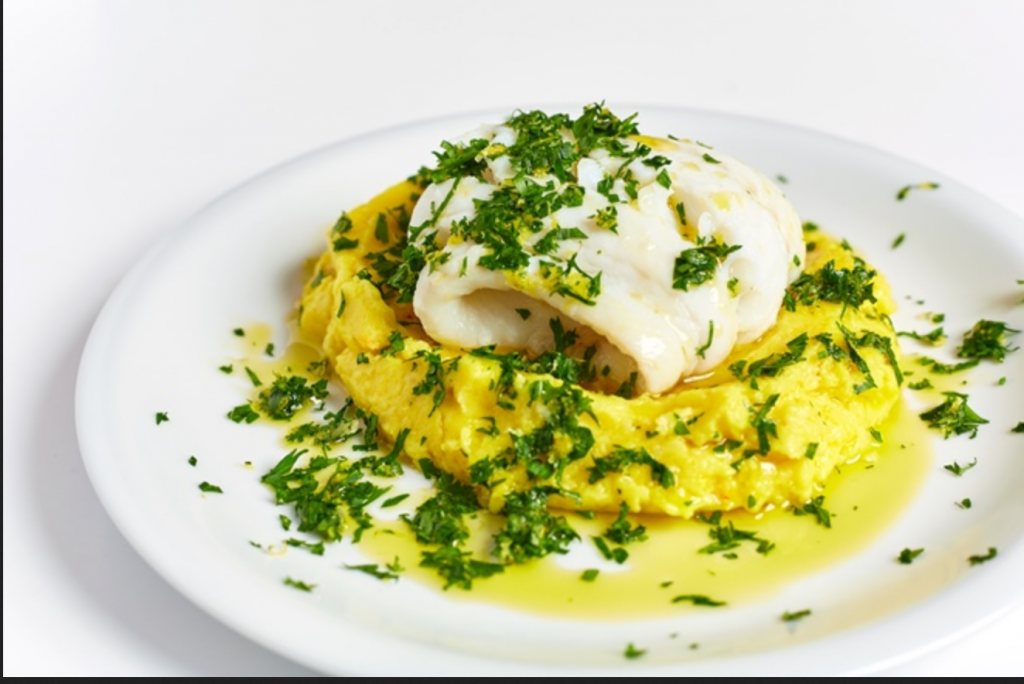
Golden Saffron Mash
Serves 4
Ingredients
2 pinches of saffron
250ml boiling water
1kg potatoes, peeled or not, as you prefer
50g butter
1 clove garlic, minced
salt and pepper
Preparation
Mix the saffron with the boiling water and set aside to infuse.
Put the potatoes, whole, in a pan and cover with cold water. Bring slowly to the boil, and then simmer over very low heat until they are very soft and tender. Depending on the size of the potatoes, this will take from 25 to 60 minutes.
Meanwhile, melt the butter in a frying pan over medium heat. Once it’s bubbling add the garlic and sauté for a minute until it begins to turn golden. Add the saffron water, and simmer for a few more minutes. Set aside.
Once the potatoes are soft, drain and then return to the pan. Mash them well.
Add the saffron butter and mash some more. Season to taste with salt and pepper and serve.
Recipe adapted from Anna Jones, The Modern Cook’s Year (2017).
Rob’s Recipe of the Week: Thyme for Soup
Much as I’m excited to get back to my favourite celeriac recipe (Celeriac Pasta Ribbons Weekly update Jan 3 2019), I’m in desperate need of replenishing my lunch stores at the moment and nothing is better than a good autumnal soup. This should use a few different items from this weeks share, so enjoy!
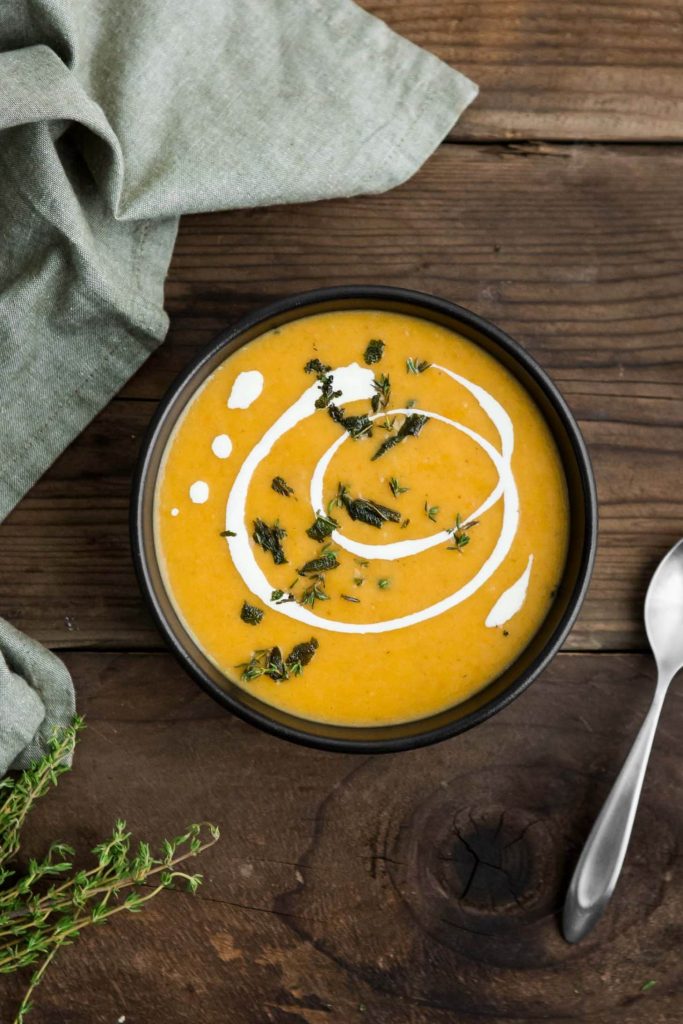
Celeriac soup with thyme
Prep Time: 15 minutes
Cook Time: 45 minutes
Total Time: 60 minutes
Yield: 2 large servings
Ingredients:
1 medium celeriac
2 carrots
2 medium potatoes
1 medium shallot (or onion if not)
2 cloves large garlic
4 tablespoons olive oil
1/4 teaspoon salt
0.75 to 1L veg stock
5 sprigs thyme
10 fresh sage leaves (I’ll probably use dried sage to save a trip to the shops)
1 to 2 tablespoons heavy cream (optional)
Preparation:
Preheat oven to 220° C (might need turning down!)
Cut off skin and roots of celeriac. Dice celeriac, carrots, and potatoes into 1cm cubes. Place on a baking sheet or in roasting pan. Roughly mince shallot and garlic. Add to dice vegetables. Drizzle with 2 tbsn olive oil and sprinkle with salt. Toss until all the vegetables are well coated. Roast in the oven 35 to 40 minutes or until the vegetables are beginning to caramelize and brown.
While vegetables are roasting, heat 2 tablespoons olive oil over medium-high heat until hot. Fry sage, 3 to 4 leaves at a time until crisp. Remove from heat and set aside.
When vegetables are done roasting, transfer them into a blender. Add thyme leaves from 5 sprigs into blender with most of vegetable stock. Puree until smooth. Add more vegetable stock to achieve the consistency you desire.
Transfer soup to a medium pot. Bring to boil over medium heat. Serve with crispy sage, extra thyme and a drizzle of heavy cream.
If you are using an immersion blender consider peeling the potatoes before roasting to achieve a smooth consistency in the soup.
The soup consistency is on the thicker side. After pureeing, add more stock if desired to get a thinner soup.
Taken from: https://naturallyella.com/celeriac-soup/
Rebecca’s Recipe of the Week: Carrots Agrodolce
‘Agrodulce’, Italian for sour-sweet, is a technique for cooking vegetables in a mixture of oil, vinegar, salt and sugar. It’s very easy; 20 minutes should be ample, unless you like to take your time in cutting the carrots into matchsticks. The results are far greater than the sum of the parts. I don’t think you will have any left over; we certainly didn’t.
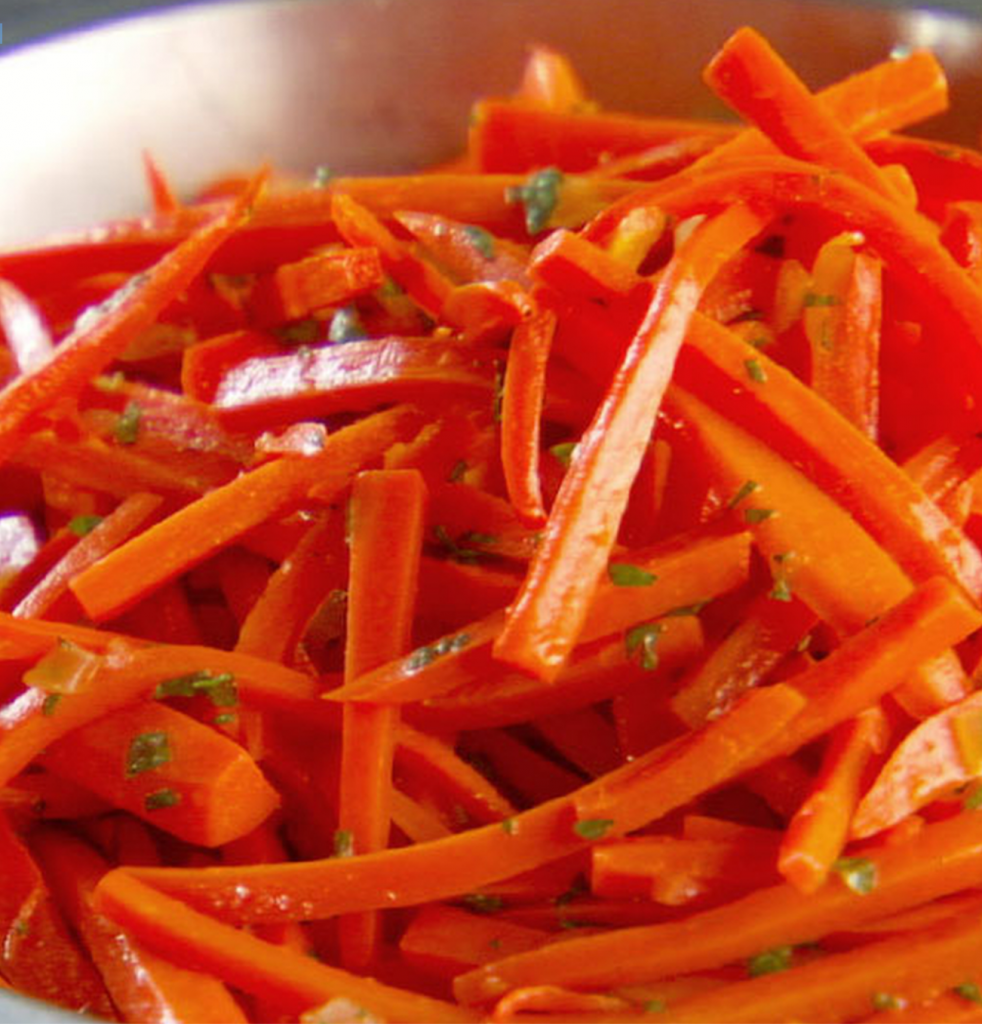
Carrots Agrodolce
Serves 3 as a side dish
Ingredients
500g carrots (peel and finely slice into matchsticks)
1½ tablespoons olive oil
1/3 cup of water
2 tablespoons minced onion
¾ teaspoon sugar
1 tablespoon red wine vinegar
¾ teaspoon salt
¼ teaspoon freshly ground black pepper
2 tablespoons fresh mint
Preparation
First cut the carrots into matchsticks. You can do this by cutting each carrot lengthwise into slabs, and then cutting each slab into thin thin matchsticks.
Place the carrots, olive oil, and water in a saucepan over medium-high heat. Bring to a boil and cook, uncovered, until the water has evaporated, which will take about 7 minutes.
Stir in the onion and cook for 1 minute. Add the sugar, vinegar, salt, and pepper, and stir until there is a glaze coating the carrots, about 30 seconds.
Remove from the heat and stir in the mint. Place in an attractive bowl and serve.
Recipe adapted from Mad Hungry.
Rebecca’s Recipe of the Week: Coconut, Potatoes, Beans
Meera Sodha’s East is excellent! Here is a gentle coconut-milk curry called an ‘istoo’, which is apparently derived from the English word ‘stew’. She recommends serving with aubergine pickle, and rice or an Indian flatbread. Some fried aubergine slices also go well.
Potato and Green Bean Istoo
Serves 2-3
Ingredients
2 tablespoons rapeseed oil
10 curry leaves
4cm cinnamon stick, broken in 2
1 medium onion (or 2 small onions), sliced
2cm piece of fresh ginger, peeled and grated
4 cloves of garlic, peeled and grated
1 green chile, slit in 2
650g small potatoes, halved
1 teaspoon each salt and pepper
1 400ml tin of coconut milk
250g green beans, topped and tailed
Preparation
In a casserole dish for which you have a lid, heat the oil on medium heat. Once it is hot add the curry leaves, cinnamon stick and onion. Reduce head to low and cook for 10 minutes, until the onion is soft but not brown. Add the ginger, garlic and chile, and cook for another 2-3 minutes.
Add the potatoes, salt and pepper and stir in the coconut milk. Then swill out the tin with about 100ml of water and add that to the pan as well. The potatoes should be just covered, so add more water if need be. Bring to a boil, and then reduce to a simmer and cook for 10-15 minutes, or until the potatoes are tender.
Add the beans, cover, and simmer for another 5 to 6 minutes, or until the beans are tender. Now it’s ready!
Recipe adapted from Meera Sodha, East (2019).
Rob’s Recipe of the Week: Sunny sweetcorn noodles
I wasn’t quite sure what to suggest this week and was resigned to the oven chips recipe I’ve been holding in reserve, until I spotted this noodle dish. It’s quite different to what I would normally cook and I’m excited to give it a try!
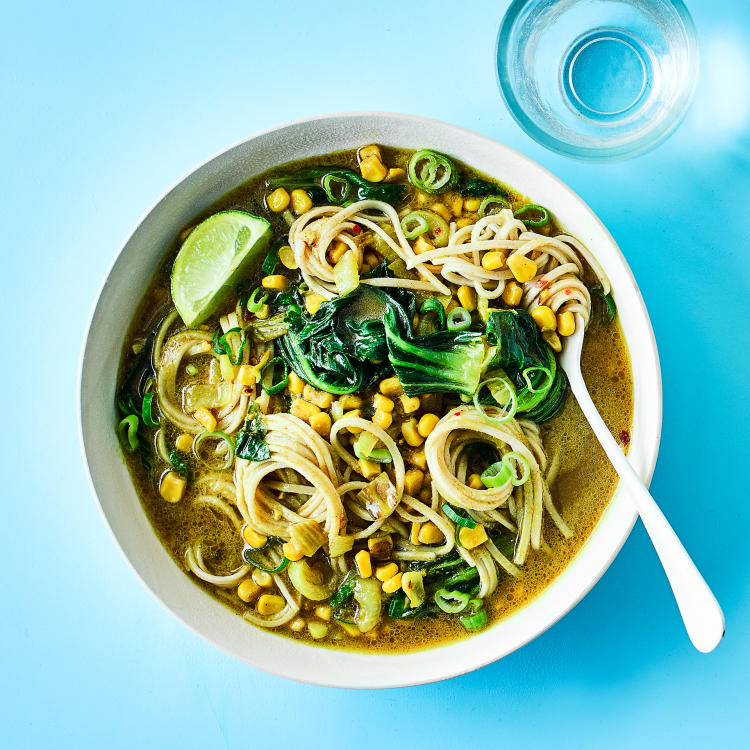
Sunny sweetcorn noodles
Ingredients:
- Chilli flakes (I’ve still got some Canalside dried chillies to get through!)
- coconut cream or coconut milk (add less water if not using cream)
- 2 garlic cloves
- 2 tbsp thai green curry paste
- lime or lime juice
- 250g pak choi
- 35ml soy sauce
- 1 spring onion (optional garnish)
- 1tsp turmeric
- sweetcorn
- noodles (2 nests)
- 1 veg stock cube
Method:
Peel and thinly slice garlic and boil the kettle
Add sweetcorn on the cob to large pan of water and boil for 10 minutes
Cut pak choi in half to separate stems from leaves. Leave leaves whole and cut stems into bitesize pieces
In a large pan (preferably with a lid) heat some oil (high heat) then add turmeric and cook for 30 seconds.
Add sliced garlic and curry paste and cook for 2 minutes
Use this time to put noodles on to boil for about 5 minutes or according to instructions
Add pak choi stems and a large pinch of salt and cook for ~3 minutes with lid on until stems are tender
If using coconut cream, mix this with stock and 350ml of hot water. If coconut milk, add this and stock direct to pan.
Add cream mix / cocunut milk and stock to the pan of veg, along with the chilli flakes and soy sauce
Set to low heat whilst you take out the sweetcorn and use a knife to separate the corn from the cob
Add sweetcorn and pak choi leaves to the pan, add water to achieve your preferred consistency and boil on low heat until leaves have wilted.
Bowl up the noodles and veg soup, adding lime juice and chopped spring onions on top if you’ve got them
Adapted from https://www.gousto.co.uk/cookbook/vegetarian-recipes/sunny-sweetcorn-noodles
Rob’s Recipe of the Week: An End-of-Summer Soup
My housemate gave me this recipe (adapted from Gordon Ramsey) because he claimed it was the best soup he’s ever had. I overspiced my attempt so i’ll leave you to decide whether he’s right! I topped up my share with a friend’s garden tomatoes, but the recipe can be scaled down if you have less than is needed. I made 5 lunch sized portions from 1.2kg of tomatoes.
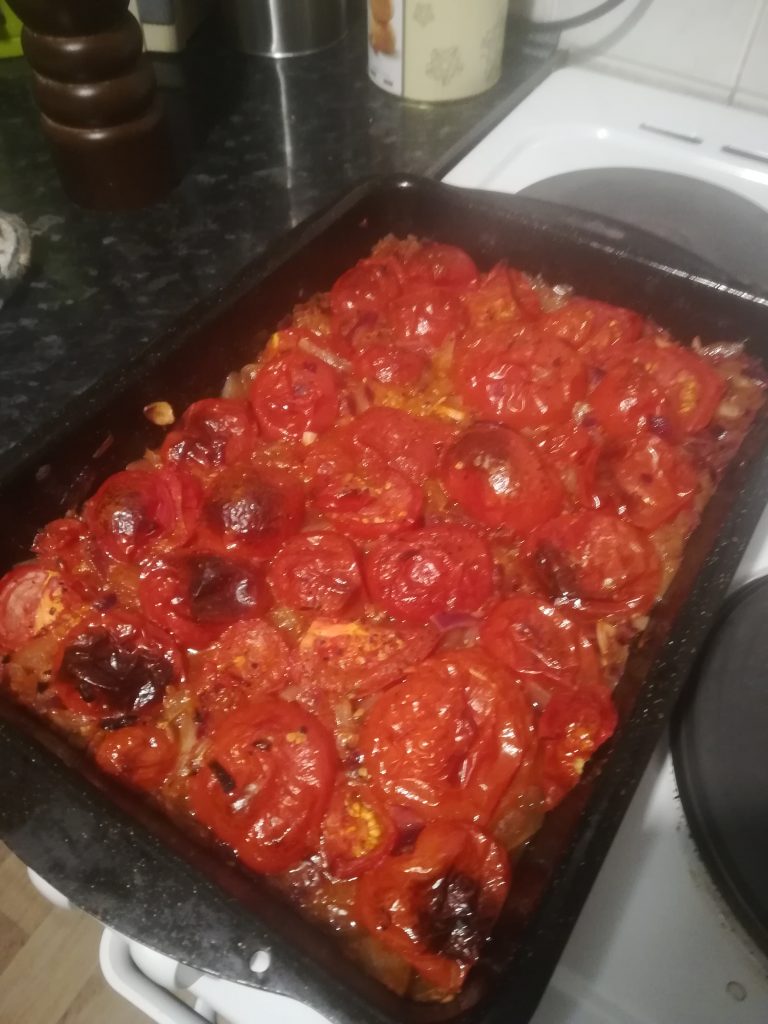
Roasting the tomatoes 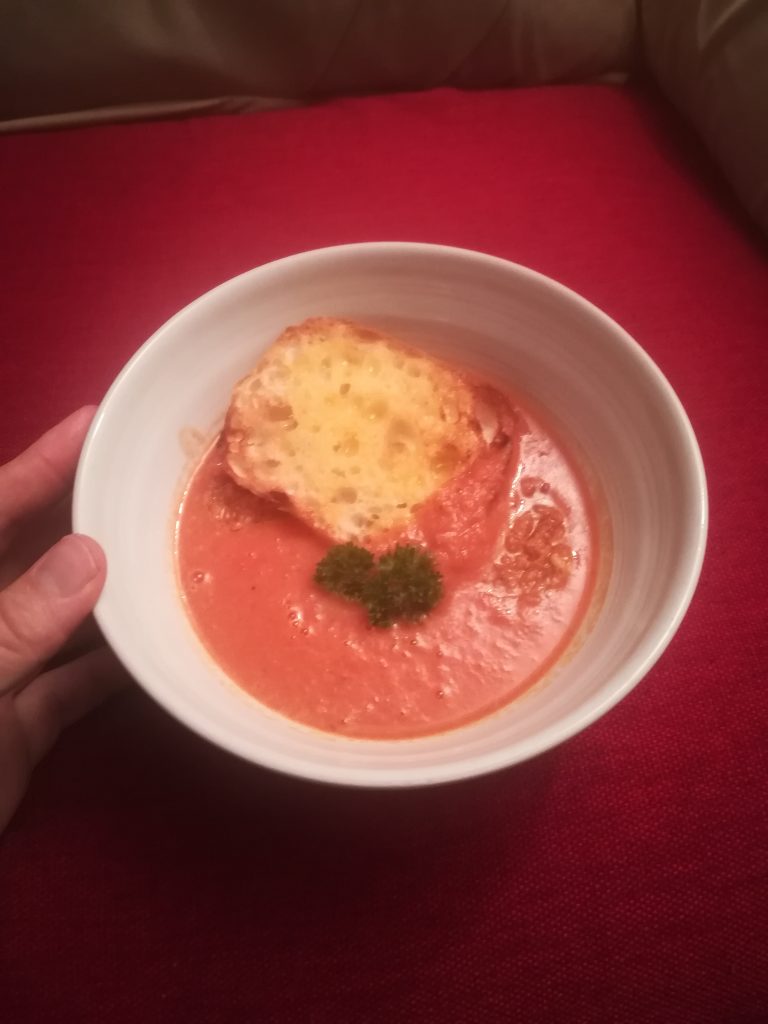
The finished soup!
Tomato soup with sundried tomato pesto
Ingredients:
SOUP:
2 red onions, peeled and sliced
2 garlic cloves, peeled and finely sliced
1⁄2–1 tsp cayenne pepper, to taste (1/2 makes for a spicy soup if you’re using CORE’s cayenne pepper!)
olive oil, for drizzling
1.5kg ripe tomatoes, cored and halved
sea salt and freshly ground black pepper
1 tsp caster sugar
1 tsp balsamic vinegar
1 litre vegetable or chicken stock
100ml double cream (soya alternative works fine)
PESTO:
2–3 tbsp pine nuts
75g sundried tomatoes, drained, oil reserved and finely chopped
50g Parmesan cheese, grated (welcome suggestions for vegan replacements, the cheese is the bulk of the pesto in this recipe so not sure you can manage without)
olive oil
Method:
Preheat oven to 180 degrees C.
Use a roasting tray on the hob at medium heat to brown the onions, garlic and pepper for a few minutes. Then add the tomatoes face down and move to high heat. Season with salt/pepper and add sugar and vinegar. Cook until tomatoes begin to caramelise (3-4 minutes). Stir and move to oven for 20-25 minutes. (If they blacken a little that’s fine, it adds to the flavour)
Make the pesto while you wait. Toast the pine nuts in a frying pan and using a pestle and mortar, pound the sundried tomatoes to a paste, season with salt and add the pine nuts, continuing to pound to resemble pesto. Stir in parmesan and add a good glug each of tomato oil and olive oil to make it look like pesto again.
Get the tomatoes out and back on the hob, adding the stock and simmering for 4-5 minutes. Then add the cream for 2-3 minutes stirring well. Then blend and serve with dollops of pesto on top!
Rebecca’s Recipe of the Week: In Praise of Potatoes
In honour of the recent potato harvest, here is a splendid Nepalese potato salad from the Idaho Potato Commission. The Andean potato probably reached Nepal some time in the 1700s; it is now become a staple. In 2017 the country harvested 2,691,037 tonnes. This salad combines potatoes, fresh coriander, and spiced yoghurt to create a complex and satisfying dish. Eat with shredded carrot salad, and perhaps some flatbread.
The Potato Commission thinks this will serve 4 people, but we ate most of it in one sitting. ‘This is scrum’ declared Matt.
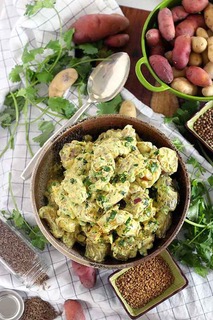
Chukauni: Nepalese Potato Salad
Ingredients
700g potatoes
1 cup frozen peas
½ cup red onion, finely chopped
½ cup fresh coriander, finely chopped
1 cup yoghurt, plus additional yoghurt, to serve
1 teaspoon salt
2 tablespoons rapeseed or vegetable oil
1 tablespoon coriander seeds
1 teaspoon cumin seeds
1 teaspoon fenugreek seeds
½ Canalside chile, finely chopped, seeds removed if desired
½ teaspoon turmeric
Preparation
Place the potatoes in a pot of cold water and bring slowly to the boil. Cook over very low heat until tender. Fish out the potatoes, drain, and set aside, keeping the water in the pan. Turn off the heat and then tip the peas into the hot water. Leave them there for 60 seconds and then drain them as well.
Once the potatoes are cool enough to handle, cut them into 2cm cubes.
Combine the peas, red onion, coriander, yoghurt and salt in a serving bowl. Stir and add the potatoes.
Heat the oil in a frying pan over medium-high heat. Once it is hot add the coriander, cumin and fenugreek seeds. Let sizzle for about 30 seconds, until they turn reddish brown. Remove from the heat and add the chile and turmeric. Toss so that the oil turns a sunny yellow.
Pour the oil–but not the seeds—over the salad. Keep as many seeds as possible back in the pan. Mix the oil into the salad and taste.
Now you have a choice: if the salad strikes you as perfectly delicious as it is, then you’re done. Serve and enjoy, with additional yoghurt on the side if you like.
If you think it needs a little more oomph, then scrape the seeds into a mortar and pestle and grind them until they’re a coarse powder. Sprinkle some or all of this into the salad, tasting as you go along. Once you’re pleased with the result, serve and enjoy.
Recipe adapted from the Idaho Potato Commission.
